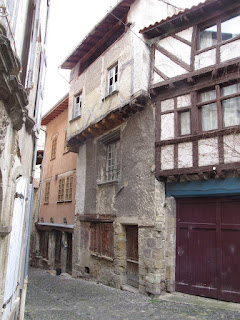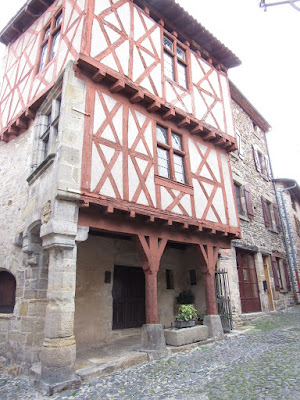We woke up to a yellow-orange sky on the morning of Saturday, February 6. It was an intriguing, apocalyptic kind of light. The Sirocco had arrived.
This peculiar light even sprinkled tiny particles of sand to create an eerie contrast to the white basilica of Lyon as well as on the snow in areas along the Swiss border near Geneva, as the following 1:23-minute video shows.
The Sirocco is a phenomenon where the wind blows sand from the Sahara Desert in North Africa onto parts of Europe. Such an event usually occurs five to six times a year, but it usually covers the central southeastern part of France (Haute Savoie and Savoie) and not the middle of the country in areas like Le Puy.
 As the day continued, the sky became milky because the dust was gradually moving away from France and over the Alps to Italy. We caught a picture of it here where the sun was uncharacteristically magnified and left silhouettes of the mountainous landscapes surrounding Le Puy.
As the day continued, the sky became milky because the dust was gradually moving away from France and over the Alps to Italy. We caught a picture of it here where the sun was uncharacteristically magnified and left silhouettes of the mountainous landscapes surrounding Le Puy.
 The sirocco arises from a warm, dry, tropical air mass that is pulled northward by low-pressure cells moving eastward across the Mediterranean Sea. The wind originates in the Sahara desert, and the hotter, drier continental air mixes with the cooler, wetter sea air to propel a counter-clockwise circulation of the mixed air across southern Europe.
The sirocco arises from a warm, dry, tropical air mass that is pulled northward by low-pressure cells moving eastward across the Mediterranean Sea. The wind originates in the Sahara desert, and the hotter, drier continental air mixes with the cooler, wetter sea air to propel a counter-clockwise circulation of the mixed air across southern Europe.
Sometimes when the Sirocco passes over the Mediterranean Sea, it picks up moisture that results in rainfall in southern Italy known locally as "blood rain" due to the red sand mixed with the falling rain.
The Sirocco is commonly perceived as disturbing to some people. Many attribute their health problems to the wind either because of the heat and dust brought in from African coastal regions or because of the cool dampness further north in Europe. The dust within the Sirocco winds can get lodged in mechanical devices and penetrate buildings.
Sirocco winds commonly occur during autumn and spring when it is very hot, and they can reach hurricane speeds of up to 100 km/h (62 mph).
This wind also has an impact on fishing. For example, the anchovies caught in the Gulf of Trieste near Barcola, Italy, which are a delicacy, are only caught during the Sirocco. When the cold winds return, the fish disappears into the vastness of the Adriatic.
For me, living in France after three-and-a-half years, it is still riveting to see weather maps of North Africa on the evening news. Riding a camel and spending two days camping in a tent in the Moroccan part of the Sahara in 2013 was a mystical experience. Today, realizing that those same desert sands were raining down on France was surreal, and I am grateful for the experience.
Sources:
L'Éveil, February 6, 2021 -- https://www.leveil.fr/puy-en-velay-43000/actualites/du-sable-du-sahara-charrie-jusque-dans-le-ciel-altiligerien_13912575/
https://en.wikipedia.org/wiki/Sirocco




































